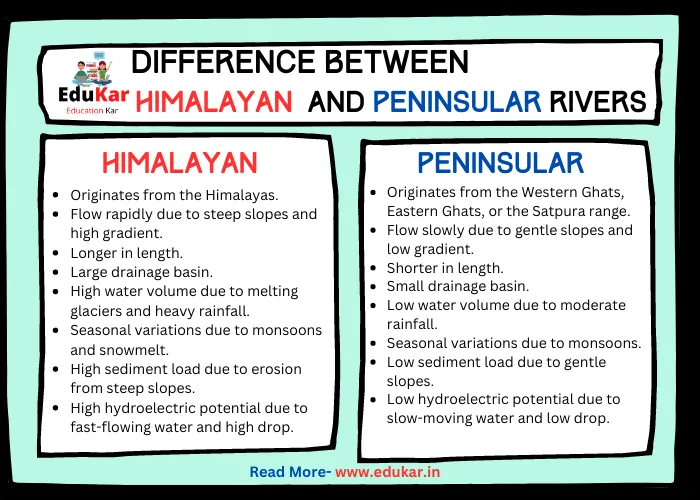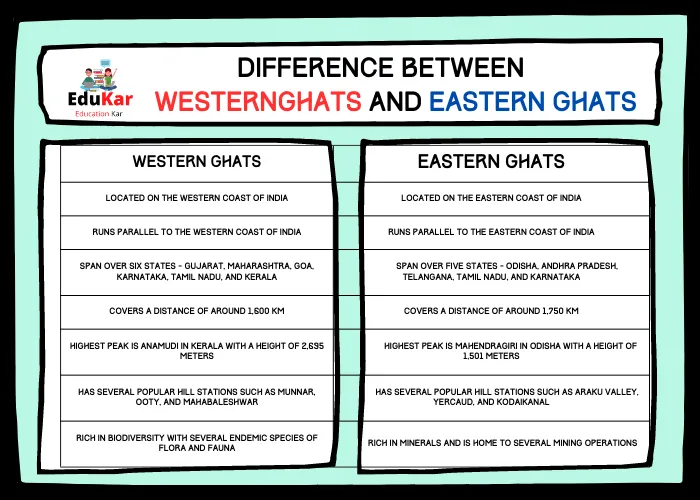Contents
- 1 Introduction
- 2 Characteristics of Himalayan Rivers
- 3 Characteristics of Peninsular Rivers
- 4 Differences between Himalayan and Peninsular rivers
- 5 Conclusion
- 6 FAQs
- 6.1 What is the main difference between Himalayan and Peninsular rivers?
- 6.2 Do Himalayan rivers carry more water than Peninsular rivers?
- 6.3 Why are Himalayan rivers more important for irrigation?
- 6.4 Which type of river has a higher potential for hydroelectric power generation?
- 6.5 Are both types of rivers important for India’s economy and ecosystem?
This article discusses the differences between Himalayan and Peninsular rivers in India, including their geography, water flow, sediment load, importance, and hydroelectric potential. Learn about the key distinctions between these two types of rivers and their significance for India’s economy and ecosystem.

Introduction
India is home to numerous rivers, which are an essential part of the country’s landscape, culture, and economy. Rivers in India are divided into two main categories: Himalayan rivers and Peninsular rivers. Understanding the differences between these two types of rivers is crucial for understanding India’s water systems and geography.
Characteristics of Himalayan Rivers
Himalayan rivers originate from the Himalayan mountain range, which is the highest mountain range in the world. These rivers are fed by the snow and glaciers that melt in the mountains, making them perennial rivers. Some of the characteristics of Himalayan rivers include:
Origin and location: Himalayan rivers originate from the Himalayan mountain range and flow through the northern and northeastern parts of India. The major Himalayan rivers are the Indus, Ganges, Brahmaputra, and their tributaries.
Length and size: Himalayan rivers are generally longer and larger than Peninsular rivers. The Ganges river, for example, is the longest river in India, with a length of approximately 2,525 km.
Water flow and sediment load: Himalayan rivers have a high water flow and carry a large amount of sediment due to the mountainous terrain they pass through. The sediment load in these rivers is responsible for the fertile soil in the plains that they flow through.
Examples of Himalayan rivers: Some examples of Himalayan rivers are the Indus, Ganges, Brahmaputra, Jhelum, Chenab, Ravi, Beas, and Sutlej.
Characteristics of Peninsular Rivers
Peninsular rivers originate from the Deccan Plateau in central and southern India. These rivers are not fed by glaciers, and their water flow depends on the monsoon rains. Some of the characteristics of Peninsular rivers include:
Origin and location: Peninsular rivers originate from the Deccan Plateau in central and southern India and flow through the peninsular region of India. The major Peninsular rivers are the Godavari, Krishna, Mahanadi, Narmada, and Tapti.
Length and size: Peninsular rivers are generally shorter and smaller than Himalayan rivers. The Godavari river, for example, is the longest Peninsular river in India, with a length of approximately 1,465 km.
Water flow and sediment load: Peninsular rivers have a low water flow and carry a small amount of sediment due to the low gradient of the land they pass through.
Examples of Peninsular rivers: Some examples of Peninsular rivers are the Godavari, Krishna, Mahanadi, Narmada, and Tapti.
Differences between Himalayan and Peninsular rivers
| Himalayan Rivers | Peninsular Rivers | |
|---|---|---|
| Origin | Originates from the Himalayas | Originates from the Western Ghats, Eastern Ghats, or the Satpura range |
| Flow | Flow rapidly due to steep slopes and high gradient | Flow slowly due to gentle slopes and low gradient |
| Length | Longer in length | Shorter in length |
| Drainage Basin | Large drainage basin | Small drainage basin |
| Water volume | High water volume due to melting glaciers and heavy rainfall | Low water volume due to moderate rainfall |
| Seasonal variations | Seasonal variations due to monsoons and snowmelt | Seasonal variations due to monsoons |
| Sediment load | High sediment load due to erosion from steep slopes | Low sediment load due to gentle slopes |
| Hydroelectric potential | High hydroelectric potential due to fast-flowing water and high drop | Low hydroelectric potential due to slow-moving water and low drop |
| Major rivers | Ganges, Brahmaputra, Indus, Yamuna | Godavari, Krishna, Mahanadi, Narmada, Tapti |
| Soil fertility | Less fertile soil due to high sediment load | More fertile soil due to low sediment load |
| Floods | Frequent and devastating floods due to high water volume | Less frequent and less severe floods due to low water volume |
| Topography | Rugged and mountainous terrain | Flat and gentle terrain |
| Importance | Crucial for irrigation, transportation, and power generation | Crucial for irrigation and domestic use |
There are several key differences between Himalayan and Peninsular rivers. Let’s explore these differences in more detail:
Origin and location:
Himalayan rivers originate from the Himalayan mountain range, while Peninsular rivers originate from the Deccan Plateau. Himalayan rivers flow through the northern and northeastern parts of India, while Peninsular rivers flow through the central and southern parts of India.
Length and size:
Himalayan rivers are generally longer and larger than Peninsular rivers. The Ganges river, for example, is the longest river in India, with a length of approximately 2,525 km, while the Godavari river, the longest Peninsular river, is approximately 1,465 km long.
Water flow and sediment load:
Himalayan rivers have a high water flow and carry a large amount of sediment, while Peninsular rivers have a low water flow and carry a small amount of sediment. This is because Himalayan rivers are fed by glaciers and snowmelt, which results in high water flow, while Peninsular rivers depend on monsoon rains for their water flow.
Importance and usage:
Himalayan rivers are more important for irrigation, transportation, and power generation than Peninsular rivers. This is because they flow through the densely populated northern plains of India, where agriculture is the mainstay of the economy. Peninsular rivers, on the other hand, are less important for irrigation and transportation due to their low water flow. However, they are still important for power generation, particularly in the Western Ghats, which is a major hydroelectric power generation region in India.
Differences in hydroelectric potential:
Himalayan rivers have a greater potential for hydroelectric power generation than Peninsular rivers due to their high water flow and the presence of many waterfalls and rapids. For example, the Bhakra-Nangal Dam on the Sutlej river and the Tehri Dam on the Bhagirathi river are some of the largest hydroelectric power plants in India. Peninsular rivers, on the other hand, have a lower hydroelectric potential due to their low water flow and the absence of major waterfalls and rapids.
Conclusion
Understanding the differences between Himalayan and Peninsular rivers is crucial for understanding India’s water systems and geography. Himalayan rivers are longer, larger, and carry more sediment than Peninsular rivers. They are also more important for irrigation, transportation, and power generation. Peninsular rivers, on the other hand, have a lower water flow and carry less sediment than Himalayan rivers, but they are still important for power generation. Overall, both types of rivers are important for India’s economy and ecosystem, and their conservation is crucial for sustainable development.
FAQs
What is the main difference between Himalayan and Peninsular rivers?
The main difference between Himalayan and Peninsular rivers is their origin and geography. Himalayan rivers originate from the glaciers and snowmelt of the Himalayan mountains and flow through the northern plains of India, while Peninsular rivers originate from the plateau region of peninsular India and flow towards the east or west coast of India.
Do Himalayan rivers carry more water than Peninsular rivers?
Yes, Himalayan rivers carry more water than Peninsular rivers due to their high water flow resulting from snowmelt and glaciers in the mountains.
Why are Himalayan rivers more important for irrigation?
Himalayan rivers are more important for irrigation because they flow through the densely populated northern plains of India, where agriculture is the mainstay of the economy. Peninsular rivers, on the other hand, have a lower water flow and are less important for irrigation.
Which type of river has a higher potential for hydroelectric power generation?
Himalayan rivers have a higher potential for hydroelectric power generation than Peninsular rivers due to their high water flow and the presence of many waterfalls and rapids.
Are both types of rivers important for India’s economy and ecosystem?
Yes, both types of rivers are important for India’s economy and ecosystem. Himalayan rivers are more important for irrigation, transportation, and power generation, while Peninsular rivers are still important for power generation and support the biodiversity of the Western Ghats.









